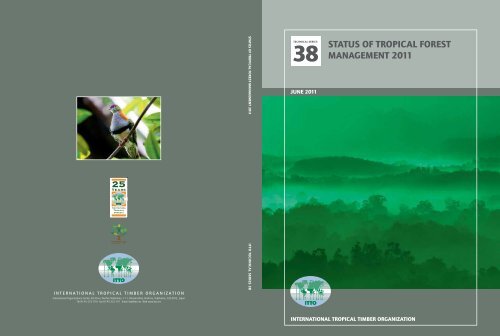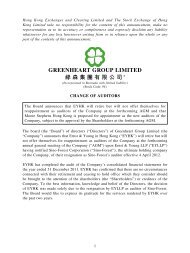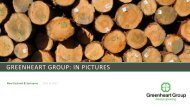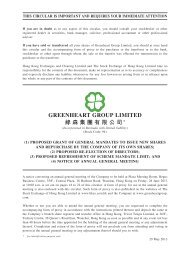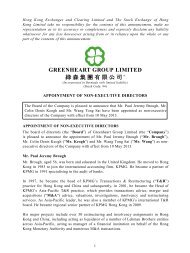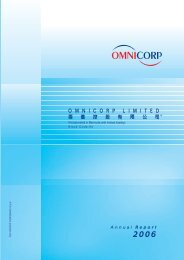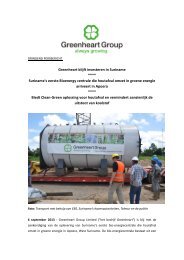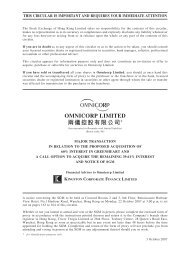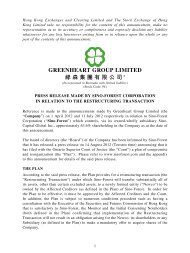status of tropical forest management 2011 - Greenheart Group
status of tropical forest management 2011 - Greenheart Group
status of tropical forest management 2011 - Greenheart Group
You also want an ePaper? Increase the reach of your titles
YUMPU automatically turns print PDFs into web optimized ePapers that Google loves.
I N T E R N A T I O N A L T R O P I C A L T I M B E R O R G A N I Z A T I O NInternational Organizations Center, 5th Floor, Pacifico-Yokohama, 1-1-1, Minato-Mirai, Nishi-ku, Yokohama, 220-0012, JapanTel 81-45-223-1110 Fax 81-45-223-1111 Email itto@itto.int Web www.itto.intStatus <strong>of</strong> <strong>tropical</strong> <strong>forest</strong> <strong>management</strong> <strong>2011</strong> itto Technical Series 38technical Serie S38JUNE <strong>2011</strong>Status <strong>of</strong> <strong>tropical</strong> <strong>forest</strong><strong>management</strong> <strong>2011</strong>INTERNATIONAL TROPICAL TIMBER ORGANIZATION
Status <strong>of</strong> <strong>tropical</strong> <strong>forest</strong> <strong>management</strong> <strong>2011</strong>Suriname• low savanna <strong>forest</strong> – 18 000 hectares• high swamp <strong>forest</strong> – 483 000 hectares• low swamp <strong>forest</strong> – 239 000 hectares• mangrove <strong>forest</strong> – 100 000 hectares• marsh <strong>forest</strong> – 468 000 hectares• ridge <strong>forest</strong> – 35 000 hectares.The Government <strong>of</strong> Suriname (2009a) estimatedthe total area <strong>of</strong> mangroves at 115 000 hectares, butFAO (2010) put the area at 100 000 hectares andSpalding et al. (2010) at about 50 900 hectares.Forest resourcesIn 2010 the estimated population <strong>of</strong> Surinamewas 524 000 people (United Nations PopulationDivision 2010), and the country is ranked 97th out<strong>of</strong> 182 countries in UNDP’s Human DevelopmentIndex (UNDP 2009). A lowland region and thesouthern highlands account for 80% <strong>of</strong> the countryand form part <strong>of</strong> the pre-Cambrian Guyana Shieldthat straddles Suriname, Guyana and FrenchGuiana. Along the northern edge <strong>of</strong> the shield liesa savanna belt, beyond which is a narrow swampycoastal plain where 90% <strong>of</strong> the population isconcentrated. The estimated <strong>forest</strong> area is 14.8million hectares (FAO 2010, Government <strong>of</strong>Suriname 2009a), which is 91% <strong>of</strong> the total landarea (16.3 million hectares).Forest types. Three broad <strong>forest</strong> zones can bedistinguished, corresponding to the three majorbiogeographical zones: the hydrophytic <strong>forest</strong>sin the north, which comprise swamp <strong>forest</strong>s,mangroves and ridge and marsh <strong>forest</strong>s; xerophyticsavanna <strong>forest</strong>s in the savanna belt; and thepredominant mesophytic humid <strong>forest</strong> types <strong>of</strong>the Guyana Shield. These, in turn, comprise thefollowing <strong>forest</strong> types a :• high dryland <strong>forest</strong> (rain<strong>forest</strong>) – 13.3 millionhectares• high savanna <strong>forest</strong> or dry evergreen <strong>forest</strong> –132 000 hectaresPermanent <strong>forest</strong> estate. There is no formallyestablished PFE in Suriname. Nevertheless, allformally established nature reserves and otherprotected and conservation areas have beenestablished by explicit legal documents thatprovide strict guidelines for protection and use,thus providing a reasonable guarantee that thoseprotected areas will be maintained as such. Sincethe establishment <strong>of</strong> the first protected areas inthe 1950s, no protected area has been revoked.Recently, a procedure has been introduced to use acompatible GIS–GPS system to determine the exactlocation <strong>of</strong> boundaries and whether any given pointon the ground is inside or outside the nature reserveor other protected area.Concession areas are also allocated on the basis <strong>of</strong>explicit legal documents that provide informationon boundaries as well as guidelines for their<strong>management</strong> and use. In practice, however, thereare few guarantees that these areas will remain inthe category <strong>of</strong> production <strong>forest</strong>. In the past, someconcessions have been converted to protectionareas or assigned to other economic uses (such asmining or large-scale agriculture). This was thecase, for example, for the community <strong>forest</strong> inthe Brokopondo district, which was allocated toCambior (now Iamgold) for gold-mining, andsome concessions in the district <strong>of</strong> Marowijne,which have been allocated to China Zhong HengTai Investment (Suriname) NV for large-scaleoil-palm plantations. The vast majority <strong>of</strong> <strong>forest</strong>sin Suriname is legally classified “as <strong>forest</strong>s to beprovisionally maintained”; <strong>forest</strong>s thus classified willbe maintained as <strong>forest</strong> until such time that they arelegally designated to a specific use.374
SurinameIn Table 1, PFE has been taken to include allformally established protected <strong>forest</strong> areas andall <strong>forest</strong> concessions and formally designatedcommunity <strong>forest</strong>s, but <strong>forest</strong>s “to be maintainedprovisionally” have been excluded. Also excludedare <strong>forest</strong>ed lands <strong>of</strong> the state that are leased toprivate individuals for conversion (mainly toagriculture), as well as privately owned <strong>forest</strong>ed landthat is currently used for timber production butcould be converted to non-<strong>forest</strong> at any time at thediscretion <strong>of</strong> the owners.Thus, 5.32 million hectares <strong>of</strong> <strong>forest</strong> may beconsidered to be designated as production <strong>forest</strong>in the PFE, while 2.19 million hectares have beendesignated for protection and conservation.Since the PFE has restricted formal <strong>status</strong>,its demarcation on the ground is minimal.Concessionaires are supposed to demarcate theirconcession boundaries but, in practice, this isgenerally confined to the cutting and maintenance<strong>of</strong> outer boundaries <strong>of</strong> the cutting compartmentunder harvest.Forest ecosystem healthDe<strong>forest</strong>ation and <strong>forest</strong> degradation. Surinamedoes not face the population and migrationpressures that have led to de<strong>forest</strong>ation in manyother countries. According to FAO (2010),Suriname lost 18 000 hectares <strong>of</strong> <strong>forest</strong> between1990 and 2010 (0.1%). The estimated <strong>forest</strong> losssince 1650 is 400 000 hectares a , or less than 3% <strong>of</strong>the extant <strong>forest</strong> estate. Until about 1980, miningon <strong>forest</strong>ed land was mainly for bauxite, whichwas exported. In the 1980s, however, gold-miningemerged as an activity <strong>of</strong> growing importance, botheconomically and environmentally. The total area <strong>of</strong><strong>forest</strong> destroyed due to gold-mining is about 90 000hectares a , including 30 000 hectares in the lastdecade (Fox 2010). An estimated 14 000 small-scaleminers and service providers work in Suriname’sinterior (ibid.). There is no significant occurrence <strong>of</strong><strong>forest</strong> fire from natural causes.At least 13 million hectares <strong>of</strong> Suriname’s <strong>forest</strong>estate is primary <strong>forest</strong> a ; Table 2 presents anestimate <strong>of</strong> 13.8 million hectares, which is slightlyless than the estimate shown in FAO (2010). Ofthe 4.5 million hectares <strong>of</strong> <strong>forest</strong> designated fortimber production, an estimated 744 000 hectareshave been logged selectively over time and moreintensively, though still selectively, in the last fivedecades. This <strong>forest</strong> is considered ‘selectively loggedprimary <strong>forest</strong>’. The low intensity <strong>of</strong> harvesting overrelatively long felling cycles has helped to maintainthese <strong>forest</strong>s in relatively good shape. About250 000 hectares <strong>of</strong> <strong>forest</strong> are used for shiftingagriculture and could be considered degraded; theextent <strong>of</strong> this area is not increasing. a There is alsoTable 1 Permanent <strong>forest</strong> estateReportingyearEstimatedtotal <strong>forest</strong>area, range(million ha)Total closednatural <strong>forest</strong>(’000 ha)PFE (’000 hectares)Production Protection TotalNatural Planted2005* 13.6–14.8 14 100 6890 7 4430 11 3272010 14.8 14 100 ** 5319 ‡ 13 † 2194 7513* As reported in ITTO (2006).** Calculated using the ratio <strong>of</strong> <strong>forest</strong> with greater than 60% <strong>forest</strong> cover estimated by UNEP-WCMC (2010) (95.5%) and theestimated total natural <strong>forest</strong> area.‡ Includes inactive concessions (either not issued or revoked or lapsed), active concessions, and community <strong>forest</strong>s.† Government <strong>of</strong> Suriname (2009a). The <strong>status</strong> <strong>of</strong> this planted <strong>forest</strong> in the PFE is unclear and is not included in the total.Table 2 Forest conditionPFE Non-PFE Total’000 haArea <strong>of</strong> primary <strong>forest</strong> 6769 7037 13 806Area <strong>of</strong> selectively logged primary <strong>forest</strong> 744 0 744Area <strong>of</strong> degraded primary <strong>forest</strong> 0 250 250Area <strong>of</strong> secondary <strong>forest</strong> 0 0 0Area <strong>of</strong> degraded <strong>forest</strong> land 0 90 90Source: ITTO estimate based on Government <strong>of</strong> Suriname (2009a) and FAO (2010).375
Status <strong>of</strong> <strong>tropical</strong> <strong>forest</strong> <strong>management</strong> <strong>2011</strong>degraded <strong>forest</strong> in the vicinity <strong>of</strong> mining operations,although the extent <strong>of</strong> this is unquantified.Vulnerability <strong>of</strong> <strong>forest</strong>s to climate change. Themean annual temperature in Suriname is projectedto increase by 0.9–3.3 °C by 2060 (McSweeneyet al. undated). Increased rainfall variability andchanges in the geomorphology <strong>of</strong> the coast and inwater resources are also projected (Government <strong>of</strong>Suriname 2002). Suriname’s low-lying coastal zoneis vulnerable to seal-level rise. This is Suriname’smost fertile land, where most economic activitiesare practised and where the population is mostlyconcentrated (ibid.). Inland <strong>forest</strong>s are vulnerableto increased drought and <strong>forest</strong> fire in extreme elNiño years.SFM policy frameworkForest tenure. According to the 1987 Constitution,all <strong>forest</strong>s, except those on privately owned land,belong to the state. Accordingly, Table 3 shows thatalmost all <strong>of</strong> Suriname’s <strong>forest</strong> estate is publiclyowned, although more than 1 million hectares havebeen allocated as private concessions (see below).The Constitution does not provide for collectiverights or the collective use <strong>of</strong> land, but Amerindianand Maroon people (the latter being descendants <strong>of</strong>slaves <strong>of</strong> African origin) claim these rights.Criteria and indicators. The Forest ManagementAct (1992) provides criteria for the sustainable use<strong>of</strong> <strong>forest</strong> resources. The Government <strong>of</strong> Surinameused the ITTO C&I in its submission to ITTO forthis report. aForest policy and legislation. The ForestManagement Act (1992) covers the sustainable andrational use <strong>of</strong> <strong>forest</strong> resources, taking into accountthe interests <strong>of</strong> <strong>forest</strong>-dwellers and the conservation<strong>of</strong> nature and biological diversity. It providesrules governing timber production (and, to someextent, timber processing) and export. It coversthe various licences for <strong>forest</strong> harvesting, includingdifferent types <strong>of</strong> timber concession and the use <strong>of</strong>community <strong>forest</strong>s.A national <strong>forest</strong> policy was adopted in 2003after an extensive process <strong>of</strong> consultation withstakeholders. This policy provides broad guidelinesfor the use <strong>of</strong> <strong>forest</strong>s for production, protectionand conservation. According to the policy, themain goal <strong>of</strong> <strong>forest</strong> <strong>management</strong> is “enhancingthe contribution <strong>of</strong> the <strong>forest</strong>s to the nationaleconomy and the welfare <strong>of</strong> the current and futuregenerations, taking into account the preservation<strong>of</strong> the biodiversity”. It contains economic,sociocultural and environmental goals <strong>of</strong> equalweight. The Interim Strategic Action Plan for theForest Sector was published in 2008.An environmental law was drafted in 2001 anda revised version is under review by the Ministry<strong>of</strong> Labour, Technological Development andEnvironment. If enacted, this law will haveimportant procedural consequences for the issuance<strong>of</strong> timber licences and the installation <strong>of</strong> timberprocessingunits. In the absence <strong>of</strong> agreed nationalC&I, the environmental impact assessmentsdescribed in the draft law will be essential formonitoring progress towards SFM.Table 3 Forest area, by tenureOwnership category Total area Of which PFE Notes’000 haState ownership (national, state orprovincial government)Other public entities, includingmunicipalities, villages, etc.*Total public 14 752 7513Owned by local communities and/or 0 0Indigenous groupsPrivate owned by individuals, firms,other corporate24 0Source: Government <strong>of</strong> Suriname (2009a).14 752 7513 PFE includes nature reserves and other protected areas,MUMAs, community <strong>forest</strong>s, inactive concessions, and activeconcessions held by firms, associations, individuals or families.Non-PFE includes ‘<strong>forest</strong>s to be provisionally maintained’, and<strong>forest</strong> for which leases have been issued for clearing anddevelopment.0 0 With its centralized government structure, Suriname’s regionalgovernments at the district and local levels do not own (<strong>forest</strong>)land.376
SurinameInstitutions involved in <strong>forest</strong>s. The governmentinstitutions responsible for the <strong>management</strong> andprotection <strong>of</strong> Suriname’s <strong>forest</strong> resources are theMinistry <strong>of</strong> Physical Planning, Land and ForestryManagement, the semi-autonomous Foundation forForest Management and Forest Control (Stichtingvoor Bosbeheer en Bostoezicht – SBB), and NB (theNature Conservation Division <strong>of</strong> the old SurinameForest Service – Lachtwet en BosBeheer, LBB). SBBis responsible for the enforcement <strong>of</strong> the ForestManagement Act (1992) and, consequently, forthe <strong>management</strong> <strong>of</strong> production <strong>forest</strong>s. NB isresponsible for the enforcement <strong>of</strong> the NatureConservation Act (1954) and the Game Act (1954)and, consequently, for the <strong>management</strong> <strong>of</strong> naturereserves and other protected areas. There has beenan ongoing process to establish a single authorityfor the <strong>management</strong> <strong>of</strong> production and protection<strong>forest</strong>s, the Forest and Nature ManagementAuthority (Bosnas), but this is still pending.Suriname has one university (Anton de KomUniversity <strong>of</strong> Suriname) with a modest schoolfor <strong>forest</strong>ry, one for biology and another forthe environment. Most currently active <strong>forest</strong>rypr<strong>of</strong>essionals in Suriname, however, receivedtheir education abroad. The Institute forNatural Resources and Engineering Studies isa well-established training institute for <strong>forest</strong>rytechnicians, one level below the Bachelor <strong>of</strong>Science. The Interim Strategic Action Plan forthe Forest Sector includes an ambitious trainingcomponent in line with the recommendationsmade on the training needs <strong>of</strong> the <strong>forest</strong> sector inthe context <strong>of</strong> ITTO pre-project proposal PPD97/04(I). The Jan Starke Vocational Training andRecreation Center provides <strong>forest</strong>-related vocationalcourses, although it is in decline.Status <strong>of</strong> <strong>forest</strong> <strong>management</strong>Forest for productionThere are several systems for timber harvesting,including concessions, community <strong>forest</strong>s andincidental cutting licences (ICLs). The proceduresfor granting concessions and licences were nottransparent in the past.Although for a decade or longer prior to theestablishment <strong>of</strong> SBB, ICLs had become a popularway to evade the relative rigid requirements forconcessions, in the last decade this practice hasbeen redressed almost completely. ICLs are nowrestricted to salvage logging areas and conversion<strong>forest</strong>s.In early 2010, a total area <strong>of</strong> 1.22 million hectares 1were under 68 active concessions, comprising 34licences for areas smaller than 5000 hectares in size(116 000 hectares in total), ten licences for areas5000–10 000 hectares in size (69 000 hectaresin total), three licences for areas 10 000–15 000hectares in size (32 300 hectares in total), fivelicences for areas 15 000–25 000 hectares in size(83 700 hectares in total), twelve licences for areas25 000–50 000 hectares in size (411 000 hectares intotal), and four licences for areas 100 000–150 000hectares in size (507 000 hectares in total). Inaddition, community cutting licences have beenissued for 437 000 hectares, and 114 000 hectareshave been designated as community <strong>forest</strong>s forIndigenous or Maroon communities. Six ICLshave been issued for a total <strong>of</strong> 54 800 hectares, andone ICL for Submerged Wood has been issued for116 000 hectares. In total, cutting licences <strong>of</strong> allforms have been issued for about 2 million hectares<strong>of</strong> <strong>forest</strong>. bEffective <strong>forest</strong> <strong>management</strong> and <strong>forest</strong> productioncontrol were virtually non-existent when SBB wasestablished in 1998 with a mandate to establish aleaner and more cost-effective <strong>forest</strong> <strong>management</strong>organization than the Forest Service it replaced.SBB subsequently developed a comprehensivecomputerized log-tracking system, LogPro, tomonitor harvesting operations, the payment <strong>of</strong><strong>forest</strong> fees and <strong>forest</strong> planning at the FMU level.Although this system is still under developmentit has already proved useful in promoting SFM.GIS technology was introduced in the <strong>forest</strong> sectorwith the support <strong>of</strong> the WWF Guianas programfor the mapping and planning <strong>of</strong> <strong>forest</strong> operationson the ground. Initially this was done for SBB’sown operations, but the system has been extendedgradually to logging companies and other privateoperators in the <strong>forest</strong> to facilitate the mutualexchange <strong>of</strong> planning and other information relatedto ground-level activities. Training courses in theuse <strong>of</strong> GIS were conducted for representatives <strong>of</strong> theprivate sector, including consultants, who are beinghired increasingly by logging companies to prepare1 In October 2010 this had reportedly increased to 1.3 million hectares in62 concessions, comprising 18 intensively managed concessionscovering 605 000 hectares, 16 extensively managed concessionscovering 55 000 hectares, and 28 “idle concession or preparatoryharvesting activities” covering 640 000 hectares. b377
Status <strong>of</strong> <strong>tropical</strong> <strong>forest</strong> <strong>management</strong> <strong>2011</strong>the planning <strong>of</strong> their operations to the (higher)standards that now prevail.The <strong>management</strong> and control style adopted bySBB can be categorized as either intensive <strong>forest</strong><strong>management</strong> (for large concessions) or extensive <strong>forest</strong><strong>management</strong> (for small concessions).Operators with a relatively large productioncapacity, including operators that produce mainlyfor export, were deemed capable <strong>of</strong> causingextensive damage to a large area <strong>of</strong> <strong>forest</strong> in arelatively short time. A high priority was thereforeplaced on ensuring their adherence to stringentregulations. Application for concessions largerthan 5000 hectares must include a businessplan (including a financial feasibility plan forwood-processing and logging activities, and a<strong>forest</strong> <strong>management</strong> plan) that sets out the intendedapproach <strong>of</strong> the applicant to the development <strong>of</strong>the concession, if granted. After the granting <strong>of</strong>the concession and before any actual harvesting, amore detailed overall <strong>management</strong> plan must besubmitted to SBB indicating the division <strong>of</strong> annualcutting areas and the infrastructure to be built.In addition, specific planning is required for eachannual cutting area for that year, including 100%inventories and the detailed layout <strong>of</strong> skiddingroads, taking into account the maximum allowablecut as suggested by the Celos Management System(normally 20–25 m³/hectare) and the selectionand marking <strong>of</strong> the trees to be felled (in the field aswell as on tree maps to be included in the planningdocuments for submission to SBB for approval).Since the requirements for 100% inventories incutting blocks were introduced, about 17 500hectares (175 blocks <strong>of</strong> 100 hectares each) havebeen surveyed in this way.Restricting harvesting to inventoried 100-hectarecutting blocks allows the close monitoring <strong>of</strong>the actual cut in relation to inventoried stock.According to observations <strong>of</strong> 87 cutting blocksexploited between 2006 and 2009, the averageharvest in intensively managed concessions was12.3 m 3 per hectare. a The average annual harvestarea for concessions and community <strong>forest</strong>s in thePFE is about 13 500 hectares.The approved harvest plan forms the basis <strong>of</strong>production control by SBB. The trees actuallycut are labelled with a polyethylene label with aunique number that is issued by SBB from LogPro,its computerized log-tracking system. Theselabel numbers, together with the tree number asassigned in the 100% tally and indicated on thetree map included in the approved harvest plan,must be entered in a felling register, as prescribedby law. The label numbers are thus linked to thetree numbers <strong>of</strong> the inventory. When the logs areprepared for transport from the production sitetheir label numbers are entered in a way bill. Ifthe original log is cross-cut prior to transport fromthe production site, the resulting smaller logs arenumbered with new labels linked to the number <strong>of</strong>the original log (and therefore automatically to thetree number assigned in the 100% tally). A copy <strong>of</strong>the felling register must be presented to the <strong>forest</strong>guard covering the particular production area, wh<strong>of</strong>orwards it to SBB headquarters, where it is enteredinto LogPro. Systematic inspections <strong>of</strong> sawmillsand other processing facilities are also conductedto ensure that any timber not seen during earlierinspections is detected, registered, and entered intoLogPro.Despite the establishment <strong>of</strong> these elaborateplanning and administrative procedures, for avariety <strong>of</strong> reasons only a relatively small area andonly a few operators are presently under such‘intensive’ <strong>management</strong>.Extensive <strong>forest</strong> <strong>management</strong> is confined tosmaller operators, including those active incommunity <strong>forest</strong>s. Such operators must maintainthe boundaries <strong>of</strong> their concessions and <strong>of</strong> theannual cutting areas in which they are active (justas in intensive <strong>management</strong>). Systematic 100%inventories are not required, but the felled timbermust be registered in a felling register, as requiredfor intensive <strong>management</strong> operations. Extensive<strong>forest</strong> <strong>management</strong> is applied in concessions wherethe impact <strong>of</strong> harvesting on the economy and theenvironment is relatively low. The ultimate goal isthat all concessions are managed according to theprocedures <strong>of</strong> intensive <strong>management</strong>. All grantedlicences, whether for intensively managed orextensively managed concessions, are monitoredby SBB. b An estimated 10–20% <strong>of</strong> (commercial)production is not registered (FAO 2010).Although there is growing interest among private<strong>forest</strong>-owners to produce timber on a sustainablebasis, for which they seek assistance from thegrowing number <strong>of</strong> consultants available for thiskind <strong>of</strong> supporting service, the practice is not wellestablished and cannot be enforced by SBB given378
SurinameForest river scene near Botopasie, Suriname. © istockphoto/B. Coendersits current capacity. a It should be noted that timberproduction in conversion <strong>forest</strong>s is, by definition,unsustainable.Under SBB, significant progress has been madetowards SFM in Suriname’s <strong>forest</strong>s, but for a variety<strong>of</strong> reasons the impact is currently sub-optimal. a Amajor constraint is the relatively low educationallevel <strong>of</strong> the <strong>forest</strong>ry workforce, although, to someextent, this problem has been reduced by thedevelopment <strong>of</strong> a group <strong>of</strong> reasonably competent<strong>forest</strong>ry pr<strong>of</strong>essionals acting as consultants to assistin the planning <strong>of</strong> operations by both smaller andlarger operators. Another major constraint for theindustry is a lack <strong>of</strong> capital, which hampers theacquisition <strong>of</strong> equipment that would, for example,enable the effective application <strong>of</strong> reduced impactlogging techniques. An even bigger constraint is <strong>of</strong>an institutional nature: the formal establishment<strong>of</strong> the Bosnas has been delayed for more than fouryears, with a consequent impact on the availability<strong>of</strong> the resources needed for adequate coverage <strong>of</strong> theentire production <strong>forest</strong> area. aSilviculture and species selection. The <strong>forest</strong>sare characterized by a wide variety <strong>of</strong> species –more than 600 tree species have been described.Some 50 species are known as class A commercialspecies and about 100 as class B. There has beena significant shift in the last three decades in thespecies harvested for industrial roundwood. Animportant reason for this shift pertains to therestricted access to the production <strong>forest</strong>s in moreremote parts <strong>of</strong> the interior during the country’scivil war (1986–1993), which led to the use <strong>of</strong>species previously considered useless or <strong>of</strong> low value.Many such species proved highly suitable for somevery demanding applications in construction andfurniture manufacturing.About 375 000 hectares <strong>of</strong> the PFE have beeninventoried for their standing timber stocks. Table 4lists some <strong>of</strong> the most commonly harvested species.Planted <strong>forest</strong> and trees outside the <strong>forest</strong>. InITTO (2006) the area <strong>of</strong> <strong>forest</strong> plantations, andthe area <strong>of</strong> plantations under <strong>management</strong> plans,were both reported at 7000 hectares. In this report,the estimated planted-<strong>forest</strong> area has been adjustedto 13 000 hectares on the basis <strong>of</strong> Suriname’ssubmission a , but the area under <strong>management</strong>plans is probably zero (Table 5). The predominant379
Status <strong>of</strong> <strong>tropical</strong> <strong>forest</strong> <strong>management</strong> <strong>2011</strong>Table 4 Commonly harvested species for industrial roundwoodSpecies Annual harvest quantity (m 3 ) NotesPFENon-PFEQualea spp* 27 175 6507 Harvested predominantly from highDicorynia guianensis* 22 114 8136dryland <strong>forest</strong>.Goupia glabra* 11 019 3851Vochysia tomentosa 4621 5502Vatairea guianensis 6644 1674* Also listed in ITTO (2006). In the case <strong>of</strong> Qualea, Q. rosea was specified in ITTO (2006).Note: Data are averages for 2004–2008.Source: Government <strong>of</strong> Suriname (2009a).Table 5 Management <strong>of</strong> the production PFE (’000 hectares)ReportingyearTotalAvailable forharvestingNaturalWith<strong>management</strong>plansCertifiedSustainablymanagedTotalPlantedWith<strong>management</strong>plansCertified2005* 6890 1740 73 0 0 7 7 02010 5319 2000 899 89 247 13 - 0* As reported in ITTO (2006).planted species for industrial purposes is Pinuscaribaea, comprising about 58% <strong>of</strong> the plantationestate. The principal indigenous species are Cedrelaspp, Cordia alliodora and Simaruba amara; the mainbroadleaved exotic species are eucalypts. There islittle information about standing volume, growthrates or current condition. No expansion <strong>of</strong> theplantation estate, or replanting <strong>of</strong> harvested sites, isplanned.Forest certification. The FSC has certified one<strong>forest</strong> area operated by Timberindustry SurinameNV, with a total production area <strong>of</strong> 23 858 hectares(FSC 2010).Estimate <strong>of</strong> the area <strong>of</strong> <strong>forest</strong> sustainablymanaged for production. Of the 1.30 millionhectares in the PFE under concessions (plus another170 000 hectares under ICLs), 899 000 hectaresare covered by, in total, 21 <strong>management</strong> plans. aTwo concessions (one <strong>of</strong> which is FSC-certified),covering a total <strong>of</strong> about 89 000 hectares, areunder harvest using reduced impact logging toa high standard. A further 158 000 hectares <strong>of</strong>concessions are being harvested using ‘controlled’logging (i.e. natural directional felling, and plannedskidding), and 655 000 hectares are being harvestedusing sometimes poor techniques. a Given thelow volume <strong>of</strong> timber extracted per hectare, thefirst two <strong>of</strong> these harvesting categories (a total <strong>of</strong>247 000 hectares) may be considered to be underSFM. Apart from some areas where gold-miningis occurring, the remainder <strong>of</strong> the production PFEis likely to be under little threat <strong>of</strong> de<strong>forest</strong>ation ordegradation.Timber production and trade. The annualproduction <strong>of</strong> industrial roundwood in 2009 wasestimated at 190 000 m 3 , up from about 94 000m 3 in 1999 and 159 000 m 3 in 2004. Sawnwoodproduction increased from 28 000 m 3 per yearin 1999 to 65 000 m 3 per year in 2009, plywoodproduction decreased from 4000 m 3 in 1999 to1000 m 3 in 2009, and veneer production increasedfrom zero in 1999 to 3000 m 3 in 2009 (ITTO<strong>2011</strong>). Installed national sawmilling capacity isestimated at 280 000 m 3 per year. In total, morethan 160 species are harvested. a In 2009, Surinameexported logs valued at US$2.70 million andsawnwood valued at US$2.80 million (ITTO<strong>2011</strong>).Non-timber <strong>forest</strong> products. NTFPs are used tovarying degrees by different groups, predominantlypeople living in the country’s interior. Apartfrom incidental small-scale efforts, no significantinventory <strong>of</strong> NTFPs has been conducted to date.There is a significant export trade <strong>of</strong> Surinamesewildlife: FAO (2010) reported that wildlife exports(mainly birds) were worth about US$404 000in 2007 (a reduction <strong>of</strong> more than US$500 000compared to 2004, due largely to a ban on bird380
SurinameTable 6 Forest carbon potentialBiomass<strong>forest</strong>carbon(MtC)% <strong>forest</strong>withcanopycover >60%De<strong>forest</strong>ation/degradationpotential to2030Enhancement<strong>of</strong> carbonsink capacityto 2030Forest areachangemonitoringcapacityForest/GHGinventorycapacityImportance<strong>of</strong> <strong>forest</strong>fire/biomassburningEngagementininternationalREDD+processes663–2753 96 + + ++ ++ + +++++ high; ++ medium; + low; estimate <strong>of</strong> national <strong>forest</strong> carbon based on Gibbs et al. (2007); estimate <strong>of</strong> % total <strong>forest</strong> with canopy cover>60% based on UNEP-WCMC (2010).imports in the European Union during an outbreak<strong>of</strong> Avian flu). In 2006 an estimated 55 000 kg<strong>of</strong> medicinal plants valued at US$453 000 wereexported to the Netherlands.Forest carbon. Suriname has a large and mostlyintact <strong>forest</strong> resource. The REDD+ mechanismis designed to assist countries like Suriname byproviding positive incentives for conserving <strong>forest</strong>sand improving <strong>forest</strong> <strong>management</strong>. Taking intoaccount Suriname’s developmental needs, REDD+could assist in mitigating some <strong>of</strong> the drivers <strong>of</strong>de<strong>forest</strong>ation and <strong>forest</strong> degradation.Gibbs et al. (2007) estimated Suriname’s <strong>forest</strong>biomass carbon stock at 663–2753 MtC, and FAO(2010) estimated it at 3165 MtC. Box 1 showsthe quantity <strong>of</strong> carbon contained in Suriname’s<strong>forest</strong>s estimated by Tjon (1998) on the basis <strong>of</strong>observations in 30 plots distributed over a range <strong>of</strong><strong>forest</strong> types.Box 1 Forest carbon stock, SurinameCarbon store (MtC)PFE Non-PFEAbove-ground biomass 1340 1210Soil 365 330Source: Based on estimates by Tjon (1998) <strong>of</strong> carbon stocks invarious <strong>forest</strong>.types.Nearly one-third (31%) <strong>of</strong> Suriname’s GHGemissions are produced by the land-use changeand <strong>forest</strong> sector (Government <strong>of</strong> Suriname 2002).Since 2009 the Government <strong>of</strong> Suriname hasbeen developing a REDD+ readiness preparationproposal in the framework <strong>of</strong> the Forest CarbonPartnership Facility and is a member <strong>of</strong> the REDD+Partnership. The preparation <strong>of</strong> a national REDD+strategy is coordinated by the National REDD+Working <strong>Group</strong>, which comprises representatives<strong>of</strong> governmental institutions, <strong>forest</strong>-dependentcommunities (Indigenous and Maroon peoples), thetimber industry, academia, civil society and otherobservers (Government <strong>of</strong> Suriname 2009b). Table6 summarizes Suriname's <strong>forest</strong> carbon potential.Forest for protectionSoil and water. No part <strong>of</strong> Suriname’s <strong>forest</strong> ismanaged exclusively for the protection <strong>of</strong> soil andwater, but the relative lack <strong>of</strong> human pressuremeans that, in effect, vulnerable slopes in thehinterlands, the productive capacity <strong>of</strong> the soils,and the water storage and production capacity <strong>of</strong>the vast majority <strong>of</strong> <strong>forest</strong>ed lands are generallywell conserved. Nevertheless, threats do exist. Forexample, some waterways are contaminated withmercury as a result <strong>of</strong> uncontrolled gold-mining,and river siltation and soil erosion are prevalent(ITTO 2003b, Fox 2010).Biological diversity. Suriname has large intact<strong>forest</strong> ecosystems <strong>of</strong> global significance and <strong>forest</strong>shave extremely high conservation and ecologicalvalues, particularly in the swamps and on theGuyana Shield. The inventoried biota comprises5800 species <strong>of</strong> plant, including 200 endemicspecies, 185 species <strong>of</strong> mammals, 668 species<strong>of</strong> birds, 152 species <strong>of</strong> reptiles, 95 species <strong>of</strong>amphibians and 790 species <strong>of</strong> fish (Malone 2007);it is certain that much remains to be discovered.Five mammals, one amphibian, one arthropodand one plant are listed as critically endangered,endangered or vulnerable on the IUCN red list <strong>of</strong>threatened species (IUCN <strong>2011</strong>). Two plant speciesare listed in CITES Appendix I, 30 in Appendix IIand one in Appendix III (UNEP-WCMC <strong>2011</strong>).Protective measures in production <strong>forest</strong>s.Harvesting guidelines to protect soil, waterand conservation values devised by SBB mustbe incorporated in the harvesting plans <strong>of</strong>concessionaires and approved prior to actualharvesting. They include the maximum allowablecut per hectare and the alignment and maximumarea <strong>of</strong> skidding roads to be constructed in a felling381
Status <strong>of</strong> <strong>tropical</strong> <strong>forest</strong> <strong>management</strong> <strong>2011</strong>compartment. In addition, rules are stipulatedin concession agreements regarding the storageand disposal <strong>of</strong> chemicals, machine oils and otherchemical waste. These are closely monitored by SBBand adhered to reasonably well by loggers, althoughstandards related to the spillage <strong>of</strong> used motor oilsand waste may slip through control from time totime, meaning that adherence may be less thanoptimal. aExtent <strong>of</strong> protected areas. According to theGovernment <strong>of</strong> Suriname (2009a), an estimated1.89 million hectares <strong>of</strong> <strong>forest</strong> are contained withinprotected areas classified in IUCN protected-areacategories I–IV, including 1.15 million hectares<strong>of</strong> lowland evergreen broadleaved rain<strong>forest</strong>. Theestimate <strong>of</strong> UNEP-WCMC (2010) is slightly lower,at 1.46 million hectares. Of particular significanceis the Central Suriname Nature Reserve, createdin 1998 (1.6 million hectares). A further 245 000hectares are in protected areas classified as IUCNprotected area categories V–VI. Just under1.5 million hectares <strong>of</strong> protected areas are coveredby <strong>management</strong> plans (Table 7). aEstimate <strong>of</strong> the area <strong>of</strong> <strong>forest</strong> sustainablymanaged for protection. Most <strong>of</strong> the protectedarea – and a large area <strong>of</strong> ‘unprotected’ <strong>forest</strong> inremote parts <strong>of</strong> the country – is intact due to a lack<strong>of</strong> development pressure. Therefore, all protectedareas subject to <strong>management</strong> plans are assumed tobe under sustainable <strong>management</strong>.Socioeconomic aspectsEconomic aspects. Forest-based activitiescontributed about 2% <strong>of</strong> Suriname’s GDP, whichwas worth about US$1.8 billion in 2007. Theformal market value <strong>of</strong> timber and NTFPs wasestimated at about US$19 million and the value<strong>of</strong> the informal market was estimated at US$2.52million. a In addition, the Water Supply Company<strong>of</strong> Suriname reported a production <strong>of</strong> 32 million m 3<strong>of</strong> drinking water in 2007, with an estimatedmarket value <strong>of</strong> US$18 million. a The water-bottlingindustry has developed rapidly in the last decadeand currently comprises at least five significant-sizedcompanies. Local consumption as well as exports <strong>of</strong>bottled water are growing steadily, although no dataon the value <strong>of</strong> these were available for this report.The Government <strong>of</strong> Suriname charges a fee per m³<strong>of</strong> timber felled and per hectare <strong>of</strong> <strong>forest</strong> concessionheld. However, there are inconsistencies in thefee structure: for example, there is little differencein the level <strong>of</strong> fees for timber according to themarketability <strong>of</strong> species and therefore there is littleincentive to use lesser-known species (moreover,local <strong>forest</strong>ry entrepreneurs consider the fees to betoo high). The fees per area <strong>of</strong> concession are verylow, which tends to encourage the application forand holding <strong>of</strong> large concessions for speculationrather than production. For these reasons, a revision<strong>of</strong> the <strong>forest</strong> charges system has been prepared,and will soon be enacted, in which the number <strong>of</strong>timber classes for fee calculation will be increased,there will be greater differentiation between timberclasses, and, overall, the average fee per m 3 will bereduced by about 50%. Concurrently, the fee perarea <strong>of</strong> concession will be increased significantly,which will help to compensate government for thedecrease in revenue resulting from the reduction inthe fee per m³. The fee per area will be lower forremote areas to encourage their development and toalleviate pressure on timber production areas closerto existing infrastructure.An estimated US$60 million has been invested inforeign-owned logging operations and processingequipment. The Government <strong>of</strong> Suriname investsin SFM through its funding <strong>of</strong> SBB and NB.Combined, those two institutions have an annualbudget for <strong>forest</strong> <strong>management</strong>, administration,research and human-resource development <strong>of</strong>about US$2.56 million. Annual grants and loansfrom international organizations amount to aboutUS$850 000. a In total, just under 1100 peoplework in the <strong>forest</strong> sector to implement or support<strong>forest</strong> <strong>management</strong>, including 133 with pr<strong>of</strong>essionalqualifications (45 in government and 88 in theprivate sector) and 135 trained (part-time orfull-time) <strong>forest</strong> workers (51 in government and 84Table 7 Management <strong>of</strong> the protection PFE (’000 hectares)ReportingyearProtection PFEAttributed to IUCNcategories I–IVAllocated for soiland waterWith <strong>management</strong>plansSustainablymanaged2005* 4430 1390 1160 - -2010 2194 1890 0 1460 a 1460* As reported in ITTO (2006).382
Surinamein the private sector). The private sector comprises29 logging companies and about 30 consultants (17<strong>of</strong> whom are university-trained). In addition, thewood-processing sector has about 2400 employees. aAbout 250 people are employed in the <strong>management</strong><strong>of</strong> protected areas (FAO 2010).Livelihood values. An estimated 65 000 Amerindianand Maroon people rely on <strong>forest</strong>s for 50% or more<strong>of</strong> their livelihoods, particularly in the districts <strong>of</strong>Sipaliwini, Brokopondo, Para and Marowijne. a Forestresources are important for medicines, buildingmaterials and fibres, but particularly for wild animals,fruit, seeds and nuts, which are major food sources.More than a thousand plant and animal species areknown to be used in one form or another (van Andelet al. 2003).People inhabiting the more remote hinterlands havevery large areas <strong>of</strong> <strong>forest</strong>s available for subsistencepurposes: while their daily activities would mostlybe confined to a couple <strong>of</strong> kilometres from theirsettlements, they may also undertake longer tripsby boat or by foot away from their settlements (e.g.for prospecting, hunting and fishing). The issue <strong>of</strong>‘how much land’ is required for customary use hasemerged in discussions regarding the land rightsclaims <strong>of</strong> Amerindian and Maroon peoples, and anattempt has been made to identify the extent <strong>of</strong> thearea around their settlements that could eventuallybe declared their economic zone. In the settlementsclosest to Paramaribo and other urban centres, theneed to share living space has given rise to a certainbalance, whereby traditional lifestyles tend to beconfined closer to settlements. However, in largepart this issue remains to be resolved.About 550 000 hectares <strong>of</strong> <strong>forest</strong> has beenallocated to Amerindian and Maroon peoples ascommunity <strong>forest</strong>s. SBB considers these to be under‘extensive’ <strong>management</strong> b , although some have beenover-exploited due to weak communal business<strong>management</strong> capacity, which allows the <strong>forest</strong>to be logged by entrepreneurs from outside thecommunities on the basis <strong>of</strong> very poor agreements. aSBB, Celos (an agricultural research organization)and WWF are working together to provide trainingthat will enhance the capacity for sustainable<strong>management</strong> among communities in the Pokigronand Marshall Creek region.Social relations. Suriname’s people comprise a racialmix <strong>of</strong> Amerindians, Creoles, Hindus, Maroons,Javanese, Chinese and Caucasians. About 10% <strong>of</strong>the population is Amerindian or Maroon, who claimcollective land-use rights, including to <strong>forest</strong>s.Amerindian and Maroon groups have soughtinternational support for their land-rights claims,including through the Inter American Court <strong>of</strong>Justice. In 2007 this court delivered a verdict infavour <strong>of</strong> the Saramaccan tribes, who had filed acomplaint that the Government <strong>of</strong> Suriname hadneglected their land rights by granting concessionsand other rights to people from outside theircommunity without their permission. The Courtordered the government to redress the disputed actsand to recognize the claimed rights.Land rights continue to be a difficult issue betweenthe government, tribal communities and otherstakeholders. The government has established an<strong>of</strong>ficial working group to help find a resolution. aSeminars, workshops and other interactivecommunication modalities involving all relevantstakeholders have, to a certain extent, proveneffective in reconciling views over <strong>forest</strong> policydevelopment and SFM. Well-identified stakeholdergroups with strong voices in such processes are:• The Platform for the Timber Sector inSuriname (PHS), comprising a relatively smallbut vocal number <strong>of</strong> private loggingentrepreneurs, with a persistent dislike <strong>of</strong> anyinitiative undertaken by the SBB.• Representatives <strong>of</strong> Indigenous and Maroonpeople who live in the <strong>forest</strong>s in the hinterlands<strong>of</strong> the country.• Several national and international NGOs,including Conservation International, WWFand Tropenbos Suriname. aSBB has also <strong>of</strong>ten been able to provide effectivemediation in conflicts between concessionairesover boundary demarcation. Where this mediationproves insufficient, the protagonists may take thecase to a judicial court. Conflict prevention, or theearly resolution <strong>of</strong> emerging conflicts between theGovernment <strong>of</strong> Suriname (particularly the <strong>forest</strong><strong>management</strong> agencies) and private operators, isattempted by providing for a representation <strong>of</strong>relevant stakeholders in the governing bodies <strong>of</strong>the <strong>forest</strong> <strong>management</strong> agencies. Representatives <strong>of</strong>stakeholders are also included in ad hoc committeesand work-groups dealing with particular issuesregarding the sustainable use and <strong>management</strong> <strong>of</strong>the country’s <strong>forest</strong> resources. a383
Status <strong>of</strong> <strong>tropical</strong> <strong>forest</strong> <strong>management</strong> <strong>2011</strong>Not all attempts at conflict resolution have beensuccessful. Some stakeholders have failed to taketheir seats in the governing bodies <strong>of</strong> existing andproposed <strong>management</strong> agencies. It has also provenvery hard to obtain agreement between the <strong>forest</strong><strong>management</strong> agencies and some stakeholders,particularly the PHS, on most <strong>of</strong> the issues subjectto discussion. aIn all sectors, including the <strong>forest</strong> sector, the rulesand requirements regarding health and safety inthe workplace are set out in the Safety Act (1947),which is administered by the Ministry <strong>of</strong> Labor,Technological Development and Environment.The Directorate for Labor in this ministry conductsfrequent inspections in different working locations,including sawmills and timber-harvesting sites. Thereis close correspondence between the prevailing labourregulations and International Labour Organization(ILO) conventions. Labour unions play a role inassuring that ILO recommendations and regulationsare taken into account and adhered to. However,labour unions have only a limited role in companiesactive in the <strong>forest</strong> sector. aAmong the 29 enterprises interviewed in thecontext <strong>of</strong> the present report, two deaths wererecorded in <strong>forest</strong>-based operations in the threeyears to 2009. In addition, three cases <strong>of</strong> permanentdisabilities and six instances <strong>of</strong> injuries followed bycomplete recovery were recorded. aThe contribution <strong>of</strong> members <strong>of</strong> the Amerindianand Maroon communities to tree-spotting andbotanical research regarding plant species in the<strong>forest</strong> is indispensable, as is their contribution to allforms <strong>of</strong> surveys in <strong>forest</strong> areas in the hinterlands. aSummarySuriname has taken some important steps towardsSFM. A GIS–GPS system has been introducedto help locate boundaries <strong>of</strong> protected areas andto assist in the mapping and planning <strong>of</strong> <strong>forest</strong>operations. A computerized log-tracking system isbeing rolled out. There is almost no de<strong>forest</strong>ation,and most <strong>of</strong> the <strong>forest</strong> estate is primary <strong>forest</strong>.There is an interim strategic action plan forimplementing the national <strong>forest</strong> policy. About2 million hectares <strong>of</strong> <strong>forest</strong> are under licence,although not all concessions are currently underharvest. There has been an ongoing process toestablish a single authority for the <strong>management</strong> <strong>of</strong>production and protection <strong>forest</strong>s, the Bosnas, butthis is still pending. A number <strong>of</strong> steps have beentaken to improve conflict resolution in Suriname’s<strong>forest</strong>s, but land rights are an ongoing issue betweengovernment, Amerindian and Maroon peoples, andother stakeholders.Key points• More than 90% <strong>of</strong> Suriname is <strong>forest</strong>ed, andvery little de<strong>forest</strong>ation is taking place.Gold-mining has become a significant cause <strong>of</strong><strong>forest</strong> and environmental degradation.• Suriname has an estimated PFE <strong>of</strong> 7.51 millionhectares (compared with 11.3 million hectaresin 2005), comprising 5.32 million hectares <strong>of</strong>natural production <strong>forest</strong> (compared with 6.89million hectares in 2005) and 2.19 millionhectares <strong>of</strong> protection <strong>forest</strong> (compared with4.43 million hectares in 2005).• As <strong>of</strong> late 2010, 62 logging concessions hadbeen allocated over a total area <strong>of</strong> 1.3 millionhectares.• An estimated 247 000 hectares <strong>of</strong> theproduction PFE is under SFM, including89 000 hectares that are certified.• An estimated 1.46 million hectares <strong>of</strong> theprotection PFE is under SFM.EndnotesabGovernment <strong>of</strong> Suriname (2009a).Personal communications with <strong>of</strong>ficials <strong>of</strong> the Government<strong>of</strong> Suriname, 2010.References and other sourcesvan Andel, T., MacKinven, A. & Bánki, O. (2003). CommercialNon-timber Forest Products <strong>of</strong> the Guiana Shield: AnInventory <strong>of</strong> Commercial NTFP Extraction and Possibilitiesfor Sustainable Harvesting. The Netherlands Committee forIUCN, Amsterdam, the Netherlands.FAO (2010). Global <strong>forest</strong> resources assessment 2010 countryreport: Suriname (available at http://www.fao.org/<strong>forest</strong>ry/fra/67090/en/).Fox, B. (2010). Gold rush is growing threat to Surinamerain<strong>forest</strong>. Associated Press, 31 August 2010 (availableat http://www.google.com/hostednews/ap/article/ALeqM5h7d2bEgNJaV-9s1ouca5UZi1sjKgD9HT9KN80).FSC (2010, website accessed December 2010). FSC certificationdatabase (searchable database available at http://info.fsc.org/PublicCertificateSearch).Gibbs, H., Brown, S., Niles, J. & Foley, J. (2007). Monitoringand estimating <strong>tropical</strong> <strong>forest</strong> carbon stocks: making REDDa reality. Environmental Research Letters 2 (available at http://iopscience.iop.org/1748-9326/2/4/045023/fulltext).384


